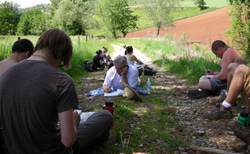News Archives - 2006
Learning to listen and see deeply in the south of France
 In
southern France, summer class begins by the side of the road or along
a river—wherever Tara Sweeney, art professor, can give a drawing
demonstration, and wherever Phil Adamo, history professor, can read a
passage from The Rule of St. Benedict, a 1500-year-old text on monastic
practice.
In
southern France, summer class begins by the side of the road or along
a river—wherever Tara Sweeney, art professor, can give a drawing
demonstration, and wherever Phil Adamo, history professor, can read a
passage from The Rule of St. Benedict, a 1500-year-old text on monastic
practice.
These students choose to study the religious experience of medieval France and to learn plein air drawing in a paired art and history short-term study abroad course. Before the course ends, they make a four-day pilgrimage, visit monasteries, cathedrals, walled towns, museums, a papal palace, and spend a week in Paris. Each keeps a daily sketchbook/journal that integrates personal reflection with history and art assignments.
In the “classroom,” Adamo teaches the Benedictine principles of monastic community, an important aspect of medieval religious practice. Students don’t simply hear about how silence helped monks to listen deeply, they are expected to practice it.
Sweeney teaches plein air drawing with readings from John Ruskin's Elements of Drawing in Three Letters to Beginners, through demonstration, and practice, and practice, and practice—the medieval master/apprentice model. Students draw at least two hours per day, wherever inspiration and travel breaks make it possible.
As they walk village to village on the centuries-old pilgrimage road, Le Chemin de St. Jacques de Compostelle, with pilgrims from around the world, they hear little English other than their own. Each night they sleep in a family-run hotel after dining on traditional local fare at long communal tables. Their pilgrimage ends in Conques, where they receive the pilgrim’s blessing at Abbaye de St. Foy.
For many, the best thing that happens on this study abroad experience keeps happening when they return. In studying to understand the past, in sketching what remains of it, students learn to listen, to see deeply, and most importantly, to be fully present.